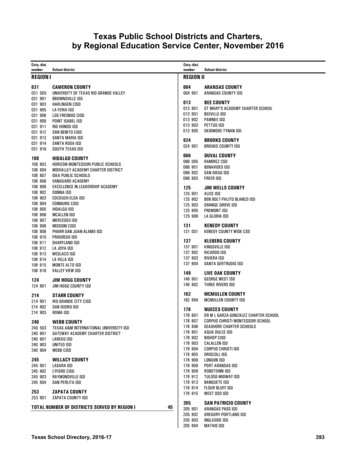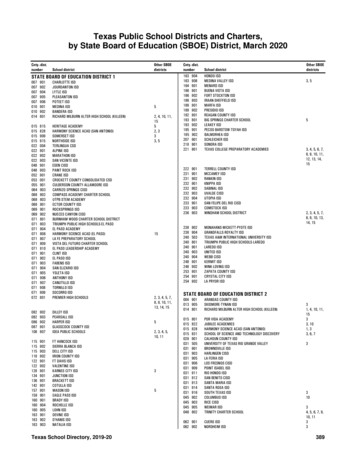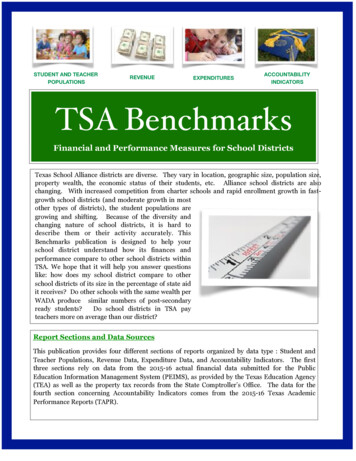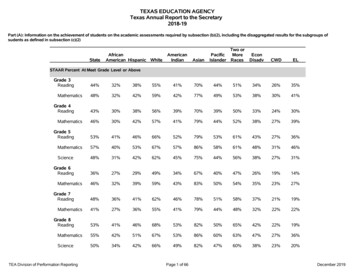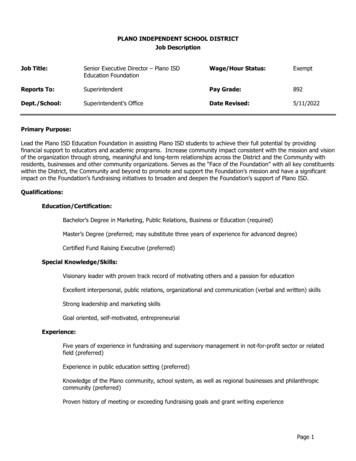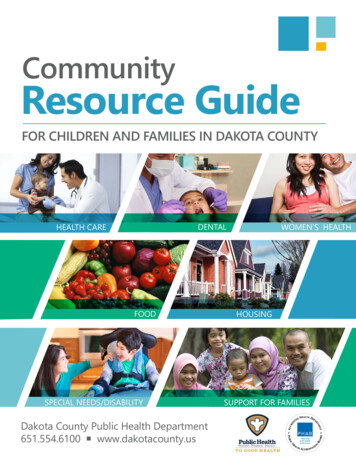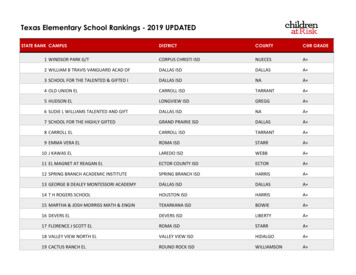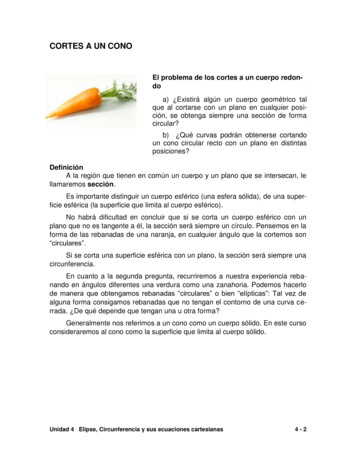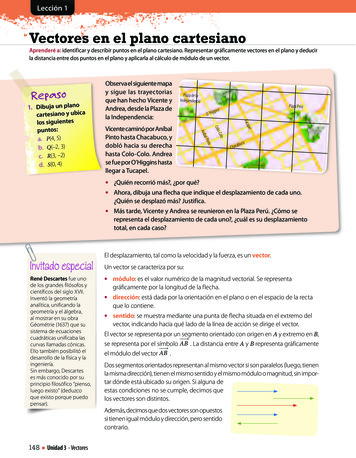
Transcription
Plano ISD AcademyProject/Problem-based instruction within a science, technology,engineering, art, and mathematics contextOverviewPlano Independent School District is seeking corporate sponsorship to help launch and sustain agrades 9-12 academy high school utilizing a student-centered, project/problem-based instructionalmodel where science, technology, engineering, art and math (STEAM) provide the context forstudents’ problems and projects throughout their classes. Recognizing that market forces, workforceneeds and student learning methods are ever-changing, in an effort to remain competitive, PlanoISD seeks to innovate and find new ways to educate students. A step toward this goal is creatingnew, engaging instructional methods.Designing the future for schoolsof choice
Executive SummaryThe Plano ISD AcademyThe mission of Plano ISD academies is to engage students in a rigorous, distinctproject-based curriculum, inspiring creativity and empowering them to collaborate andcompete globally.The Plano ISD Board of Trustees created the Academy Visioning Committee in spring2010 to provide a recommendation for the first academy of the Plano IndependentSchool District.The Academy Visioning Committee was given the charge to study and advise the feasibility ofcreating an option for 9th-12th grade students that offers choices for programs not currentlyavailable in the comprehensive high schools and senior high schools. The Visioning Committee wasexpected to consider and utilize the District vision, mission and Portrait of a Graduate.The committee consisted of over 70 participants and included parents, students, central and campusstaff members, higher education representatives, business and community members. Thecommittee held 15 meetings from May 2010 through January 2011 to research best practices,consider current Plano ISD offerings, hear from current students and recent graduates, and toengage in discussions to explore the best way to create future focused choices that will preparestudents for college and careers. The Visioning Committee also conducted a Community Meeting inNovember 2010 to get input from community members concerning an academy.The recommendations of the Visioning Committee are provided in the accompanying document ofFindings and Directions. Findings are philosophical statements that describe how the committeebelieves instruction should be facilitated and supported in an academy, and Directions arestatements that describe how the Findings will be accomplished. Findings and Directions weredefined in the following areas: Mission and FocusTeaching, Learning and ExpectationsSchool SizeCounseling and AdvisoriesTimeTechnologyPerforming and Visual Arts Career and Technical EducationPhysical Education and AthleticsCollege and Work Force ConnectionsClubs and Student ActivitiesSchool and CommunityOrganization of Instructional SpacesFollowing the work of the Academy Visioning Committee, internal staff work groups were formed toaddress the implementation of the findings put forth by the committee. The areas of implementationincluded the program of study, staffing model, school organization, transportation, space utilization,program evaluation, and community partnerships. This work was accepted and approved by theBoard of Trustees at their April 5, 2011 meeting.2
Academy Program of StudyThe Visioning Committee provided a clear recommendation regarding the program of study identifiedthrough their months of deliberation and input provided by panels of current students and recentgraduates.The Committee and Administrative staff recommendthat the program of study center around PBL—projectand problem based learning experiences. Thisinstructional method is used throughout the district invarious grade levels and courses, but has not beenthe central point of focus for an integrated deliverysystem. The Plano ISD Academy is being designedand developed with PBL as the primary instructionalpractice for all content areas.The curriculum will be developed locally by aninterdisciplinary team of high school teachers who willlikely form the initial cadre of teachers in the academy. With the assistance of consultants from theBuck Institute for Education, curriculum coordinators and curriculum leadership will facilitatedevelopment of course curricula. Through the curriculum development process, appropriate coursecombinations, compactions, and content integration will emerge. PBL will be the primary instructionaldelivery approach.In addition, the committee recommended that a STEAM (science, technology, engineering, digitalarts, mathematics) theme provide a unifying context and construct throughout various course PBLs.The internal curriculum development process will ensure that students in the academy have a fullyinclusive experience utilizing STEAM topics as anchor points to align to the appropriate TexasEssential Knowledge and Skills in each course.Development of grades 9 and 10 course curricula will begin in the summer of 2012 and will continuethrough early August of 2013. Initial work in the summer of 2012 will be professional developmentfocused on a deep understanding of PBL pedagogy and on the interdisciplinary curriculumdevelopment process. Course curricula for grades 9 and 10 courses will emerge throughout the2012-13 school year culminating in August 2013. Course curricula and initial professionaldevelopment will be completed for an August 2013 launch of the academy with 9th and 10th gradestudents. Subsequent curricula and students would be added a year at a time with the firstgraduating class in 2015-16.An important component of the academy will be the community and corporate partnerships.Students will be expected to take advantage of internship opportunities provided by corporatepartners as part of their course work. Likewise, we anticipate that corporate partners will providementors to be on site with students and help direct student learning as well as provide externalevaluation of student projects.On April 19, 2011, the Board of Trustees approvedthe purchase of a facility to house this initial academyin central Plano. This will provide easy access forstudents throughout the district. The facility is a threestory office building previously used by a majortelecommunications company as their local Internetservices network operations center. The facilityfeatures large, open areas particularly amenable toPBL instructional delivery and includes adequateenclosed areas to be used as studio and workshop3
areas as necessary by students and staff to facilitate a variety of learning and production needs. Weanticipate that major corporate partners will also have space for an ongoing presence in the facility.Efforts are now underway to create a project timeline and identify major corporate partners for theacademy. We envision our partners playing an active role as we map the curriculum for our studentsand teachers and become members of the Academy Steering Committee to help provide long-termoversight of the overall academy effort.Trends and OpportunitiesRemaining competitive and responsive to the profile of today’s learner, Plano ISD seeks to innovateand find new ways to educate students. Plano ISD is known for being on the leading edge ofeducation and takes seriously its responsibility to students and to the future of public education inTexas.The Board of Trustees adopted a strategic plan entitled "future focused” and created a portrait of agraduate that describes the attributes desired for students graduating from Plano schools.Plano ISD graduates will be empowered to:- Proactively adapt to new learning opportunities throughout their lives.- Collaborate with and contribute to the global community.- Be both creative and disciplined in their thinking.The school board and district administrators also recognized that PlanoISD should:- Engage the digital learner.- Allow students to be creators of knowledge, not just consumersof it.- Use multiple types of assessments to measure studentachievement.- Transform the state’s current accountability model into one thatinspires rather than referees.- Transform our school organizations from bureaucracies intolearning organizations.- Shift away from the district’s role as an agent of compliance to amore balanced local-state partnership.Plano ISD offers a wide spectrum of programs and services today. Mostof them are offered on home campuses, but some are available on anopt-in basis at one location. Existing examples of academy and magnetstyle programs include the:- International Baccalaureate program at Plano East Senior High.- Culinary Arts program at Plano East Senior High.- Auto Body program at Plano Senior High.- Math Rocks program at 10 schools.The academy will engage students in a rigorous and distinct project-based curriculum, inspiringcreativity and empowering them to collaborate and compete globally. The instructional methods ofproject based learning will be incorporated at the academy and course work will be focused aroundthe context of science, technology, engineering, art and math.4
Timeline – History and ProjectionsMay 2010:September 2010:October 2010:November 2010:Academy Visioning Committee convenes and receives charge and scope of workas assigned by the Plano ISD Board of Trustees.Academy Visioning Committee begins their work in discovery and study as awhole.Academy Visioning Committee presents an update of their collective work to thePlano ISD Board of Trustees.Community input meeting hosted at Plano Senior High School regarding theacademy concept.February 2011:Academy Visioning Committee makes a formal recommendation to the Plano ISDBoard of Trustees to pursue the academy concept and reveals their mission,parameters and Findings and Directions document.March 2011:The Plano ISD administrative staff reports their work to the Plano ISD Board ofTrustees in a work session setting regarding concepts and models for academystaffing, school organization, transportation, space utilization, program evaluation,community partnerships and frameworks for future academies.April 5, 2011:April 19, 2011:Spring 2012:Fall 2013:The Plano ISD Board of Trustees approves the academy concept andimplementation of a PBL-based learning academy.The Plano ISD Board of Trustees approves the purchase of an existing facility asthe intended location of the academy.Identify staff and begin curriculum and staff development.Opening of the academy.OutcomesCorporate Partnershipsps5
Plano ISD offers a wide spectrum of programs and services today. Most of them are offered on home campuses, but some are available on an opt-in basis at one location. Existing examples of academy and magnet-style programs include the: - International Baccalaureate program at Plano East Senior High. - Culinary Arts program at Plano East Senior High.

